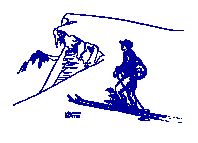Greg Jordan and I decided to go on a 3-day trip to the White Mtn. Such trips are difficult to schedule as Sierra Club trips due to the unpredictability of the snow. But the Ranger and the White Mtn Research personnel assured us of "adequate" snow. Equipped with nonwaxable metal-edged skis, plenty of warm clothes, a Bibler tent with hanging stove, and "light" (45 lbs) packs we left Sat morning at 6:45am from the locked gate at Sierra View Overlook (9,280').
![]()
![]() After an hour walk on the dry road we enjoyed the first skiable snow at Schulman Grove. Unfortunately, the conditions changed about every mile and we had to walk and ski alternately for the rest of the day. Touring in the Whites brings about a different sense for time and distance: The seemingly endless rolling terrain requires hours and hours of persistent motion to make a change. In the morning we saw the bristlecones near the Schulman Grove, 10 mi further we had lunch under bristlecones near the Patriarch Grove, and another 10 mi further at sunset we pitched tent in the tundra below Mt Barcroft. With increasing elevation the temperatures dropped and a steady cold wind blew so that life outside the tent was miserable. Low clouds rolled in. We enjoyed hot drinks and dinner inside the tent since we were tired of the 20mi, 4000' day. We were somewhat dehydrated since we had only one quart of water for the day. The only available fluids come from melting snow, which requires an adequate supply of butane gas (at least 1 can/day for 2 persons).
After an hour walk on the dry road we enjoyed the first skiable snow at Schulman Grove. Unfortunately, the conditions changed about every mile and we had to walk and ski alternately for the rest of the day. Touring in the Whites brings about a different sense for time and distance: The seemingly endless rolling terrain requires hours and hours of persistent motion to make a change. In the morning we saw the bristlecones near the Schulman Grove, 10 mi further we had lunch under bristlecones near the Patriarch Grove, and another 10 mi further at sunset we pitched tent in the tundra below Mt Barcroft. With increasing elevation the temperatures dropped and a steady cold wind blew so that life outside the tent was miserable. Low clouds rolled in. We enjoyed hot drinks and dinner inside the tent since we were tired of the 20mi, 4000' day. We were somewhat dehydrated since we had only one quart of water for the day. The only available fluids come from melting snow, which requires an adequate supply of butane gas (at least 1 can/day for 2 persons).
On Sun morning the sky was clear. Our plan was to go for the peak and to return to camp. However, we decided to break camp in the morning just in case low clouds would roll in, requiring an impossible search for a small tent in a white out in the vast tundra.
![]()
![]() We left at 7:15am, deposited our main packs at the Barcroft Research Station of the University of California, and proceeded to ski with daypacks toward the White Mtn, about 5.5mi from Barcroft. In spite of the higher elevation there were large areas without snow, presumably carried away by the strong winds. The remaining snow consisted of hard slabs frequently with underlying depth hoar. It was a difficult survival skiing.
We left at 7:15am, deposited our main packs at the Barcroft Research Station of the University of California, and proceeded to ski with daypacks toward the White Mtn, about 5.5mi from Barcroft. In spite of the higher elevation there were large areas without snow, presumably carried away by the strong winds. The remaining snow consisted of hard slabs frequently with underlying depth hoar. It was a difficult survival skiing.
After a careful descent we were back at the Barcroft Station at 2pm. Since the weather was fine we decided to ski back until sunset. This brought us to the Patriarch Grove where we camped on a snowfield among bristlecones, which may have sprouted at the times of Moses. Again, we enjoyed a warm tent, a hot meal, and a long night's sleep.
![]() On Monday, our third day, we left at 7:30am to ski/walk out the remaining 15mi. We noticed how rapidly the snow had melted since we skied in. Furthermore, a snowcat had moved in from Silver Canyon and cleared the road of our precious white substance. Thus, it was time to leave.
On Monday, our third day, we left at 7:30am to ski/walk out the remaining 15mi. We noticed how rapidly the snow had melted since we skied in. Furthermore, a snowcat had moved in from Silver Canyon and cleared the road of our precious white substance. Thus, it was time to leave.
![]() At 12 noon we were back at the car. People looked strangely at us, perhaps because we had not seen anyone in 3 days.
This ski trip was more of an expedition than a fun telemark trip. The area is unique, fascinating and genuine wilderness off-season. Because we had relatively good weather we could make the 52mi, +-6000' trip in 2 1/2 days. In bad weather, heavy snow or with a large group much more time would be required.
At 12 noon we were back at the car. People looked strangely at us, perhaps because we had not seen anyone in 3 days.
This ski trip was more of an expedition than a fun telemark trip. The area is unique, fascinating and genuine wilderness off-season. Because we had relatively good weather we could make the 52mi, +-6000' trip in 2 1/2 days. In bad weather, heavy snow or with a large group much more time would be required.
Back to Trip Reports
Back to SMS Home Page
